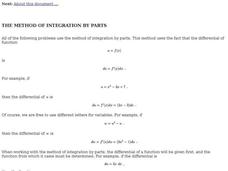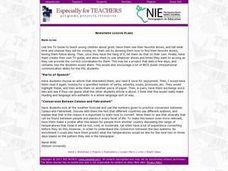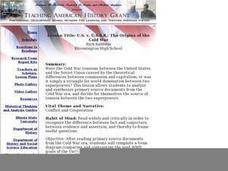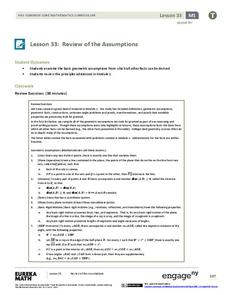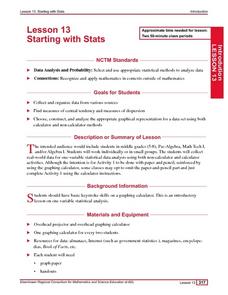Curated OER
The Method of Integration by Parts
In this calculus learning exercise, students perform integration by parts. They solve differential equations as they use integration by part to solve unlike terms. There are 23 problems with an answer key.
Curated OER
Math - Design a Ship
Students design a ship. They calculate square footage and draw their ship to scale. They build models of their ships.
Curated OER
Division Without Remainder #1
For this basic division worksheet, learners solve 17 problems in which one and two digit numbers are divided with no remainders. The problems are written in this format: 24 : 4.
Curated OER
Adding One to Nine
Give your students a chance to review their basic addition with these twenty-five problems. All problems include single digits, and some problems add up to ten. The problems are presented as column addition problems, making it an ideal...
Curated OER
Using a Multiplication Table
Students complete patterns on a multiplication table. In this multiplication table instructional activity, students use partially completed multiplication tables to find the missing patterns to solve the table.
Curated OER
Single Digit Addition
In this addition worksheet, 1st graders complete single digit addition. Students solve for 6 horizontal problems, tracing the numbers, and coloring the correct number of shapes to demonstrate the addition problem that is given.
Curated OER
Multiplying By 0
For this multiplication worksheet, learners solve 24 problems in which a single digit is multiplied by zero. These are basic facts in a vertical format.
Curated OER
Multiplying By 7
For this multiplication worksheet, students solve 12 problems in which a single digit number is multiplied by 7. These are basic facts in a vertical format.
Curated OER
Dragon Math
Third graders, in groups, practice multiplication by putting five multiplication problems on white scales, then the answers on florescent colored scales.
Curated OER
Junk Yard Math
Third graders explore the process of place value and subtraction through regrouping and borrowing exercises. Several activities using manipulatives are utilized in the lesson.
Curated OER
Math Grids
Fourth graders read an article, then search for verbs, adverbs, nouns, pronouns, etc. In groups, they exchange papers and try to guess what the other poem was about.
Curated OER
Tessel Your Way to Nagano!: Olympics, Winter Sports, Snowboarding, Graphic Design, Geometry, Math, M.C. Escher, Tessellations
Students create Post-It note fundamental regions to tesselate. They make tesselations using computer software or websites. They create a jacket design with tesselation and determine the cost of production.
Curated OER
Math: Christmas Count Down
Students use various tools to calculate the number of days before Christmas. Among the tools are number lines, calendars, and the Internet. Each day, a student visits a Christmas Countdown Website to report the days left. At the end of...
Curated OER
Fractions-Common Denominator #1
If students are in need of some repetition to master subtracting fractions with common denominations, you might consider this worksheet. This worksheet contains 15 subtraction problems of fraction with common denominators.
EngageNY
Review of the Assumptions (part 1)
What was the property again? Tired of hearing this from your pupils? Use this table to organize properties studied and as a reference tool for individuals. Learners apply each property in the third column of the table to ensure their...
EngageNY
Properties of Parallelograms
Everyone knows that opposite sides of a parallelogram are congruent, but can you prove it? Challenge pupils to use triangle congruence to prove properties of quadrilaterals. Learners complete formal two-column proofs before moving on to...
Curated OER
Addition Word Problems 1, Version 1
In this addition worksheet, students solve word problems containing one and two digit numbers. Students complete 5 addition word problems.
Curated OER
Starting With Stats
Statisticians analyze a data set of student IQs by finding measures of central tendency and dispersion such as mean, median, mode, and quartiles. They practice using a graphing calculator to find the values and analyze box plots and...
Curated OER
Conditional Probability and Probability of Simultaneous Events
Your statisticians examine the characteristics of conditional probability and the probability of simultaneous independent events. They perform computer activities to find probabilities for simple compound events. They examine the...
PBL Pathways
Medical Insurance 2
Make an informed decision when choosing a medical insurance provider. An engaging lesson asks your classes to write piecewise models to represent the cost of different medical plans. The project-based learning activity is a variation of...
Illustrative Mathematics
Checking a calculation of a decimal exponent
In a writing prompt, learners are asked to check the calculation of a decimal exponent without a calculator. Use as an opener or assessment after studying fractional exponents. Requires a strong understanding of exponents and roots to...
Illustrative Mathematics
Equivalent fractions approach to non-repeating decimals
Trying to get your class to think of decimals as fractions and vice versa can lead to interesting discussions. After all, we can usually understand quickly that 1/4 is .25 but why is 1/7 not so easy to convert? This activity looks...
EngageNY
Properties of Area
What properties does area possess? Solidify the area properties that pupils learned in previous years. Groups investigate the five properties using four problems, which then provide the basis for a class discussion.
Curated OER
It's About Time!
Students examine concept of time, and explore difference between analog and digital clocks; students make art project to represent time and create a time-story problem and solution.
Other popular searches
- Basic Facts Math History
- Basic Facts Math Lessons
- Basic Math Facts Drill
- Math Worksheets; Basic Facts
- Maths Basic Facts
- Esl Math Basic Facts
- Esol Math Basic Facts
- Basic Facts Math
- Math Worksheets Basic Facts
